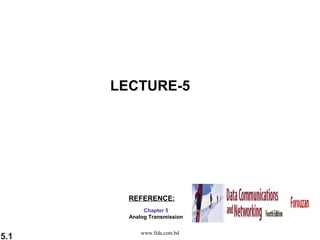
LECTURE-5 (Data Communication) ~www.fida.com.bd
- 1. LECTURE-5 REFERENCE: Chapter 5 Analog Transmission www.fida.com.bd 5.1
- 2. 5-1 DIGITAL-TO-ANALOG CONVERSION Digital-to-analog conversion is the process of changing one of the characteristics of an analog signal based on the information in digital data. Topics discussed in this section: Aspects of Digital-to-Analog Conversion Amplitude Shift Keying Frequency Shift Keying Phase Shift Keying Quadrature Amplitude Modulation 5.2
- 3. Figure 5.1 Digital-to-analog conversion 5.3
- 4. Figure 5.2 Types of digital-to-analog conversion 5.4
- 5. Note Bit rate is the number of bits per second. Baud rate is the number of signal elements per second. In the analog transmission of digital data, the baud rate is less than or equal to the bit rate. 5.5
- 6. Example 5.1 An analog signal carries 4 bits per signal element. If 1000 signal elements are sent per second, find the bit rate. Solution In this case, r = 4, S = 1000, and N is unknown. We can find the value of N from 5.6
- 7. Example 5.2 An analog signal has a bit rate of 8000 bps and a baud rate of 1000 baud. How many data elements are carried by each signal element? How many signal elements do we need? Solution In this example, S = 1000, N = 8000, and r and L are unknown. We find first the value of r and then the value of L. 5.7
- 8. Figure 5.3 Binary amplitude shift keying 5.8
- 9. Figure 5.4 Implementation of binary ASK 5.9
- 10. Example 5.3 We have an available bandwidth of 100 kHz which spans from 200 to 300 kHz. What are the carrier frequency and the bit rate if we modulated our data by using ASK with d = 1? Solution The middle of the bandwidth is located at 250 kHz. This means that our carrier frequency can be at fc = 250 kHz. We can use the formula for bandwidth to find the bit rate (with d = 1 and r = 1). 5.10
- 11. Example 5.4 In data communications, we normally use full-duplex links with communication in both directions. We need to divide the bandwidth into two with two carrier frequencies, as shown in Figure 5.5. The figure shows the positions of two carrier frequencies and the bandwidths. The available bandwidth for each direction is now 50 kHz, which leaves us with a data rate of 25 kbps in each direction. 5.11
- 12. Figure 5.5 Bandwidth of full-duplex ASK used in Example 5.4 5.12
- 13. Figure 5.6 Binary frequency shift keying 5.13
- 14. Example 5.5 We have an available bandwidth of 100 kHz which spans from 200 to 300 kHz. What should be the carrier frequency and the bit rate if we modulated our data by using FSK with d = 1? Solution This problem is similar to Example 5.3, but we are modulating by using FSK. The midpoint of the band is at 250 kHz. We choose 2Δf to be 50 kHz; this means 5.14
- 15. Figure 5.7 Bandwidth of MFSK used in Example 5.6 5.15
- 16. Example 5.6 We need to send data 3 bits at a time at a bit rate of 3 Mbps. The carrier frequency is 10 MHz. Calculate the number of levels (different frequencies), the baud rate, and the bandwidth. Solution We can have L = 23 = 8. The baud rate is S = 3 MHz/3 = 1000 Mbaud. This means that the carrier frequencies must be 1 MHz apart (2Δf = 1 MHz). The bandwidth is B = 8 × 1000 = 8000. Figure 5.8 shows the allocation of frequencies and bandwidth. 5.16
- 17. Figure 5.8 Bandwidth of MFSK used in Example 5.6 5.17
- 18. Figure 5.9 Binary phase shift keying 5.18
- 19. Figure 5.10 Implementation of BASK 5.19
- 20. Figure 5.11 QPSK and its implementation 5.20
- 21. Example 5.7 Find the bandwidth for a signal transmitting at 12 Mbps for QPSK. The value of d = 0. Solution For QPSK, 2 bits is carried by one signal element. This means that r = 2. So the signal rate (baud rate) is S = N × (1/r) = 6 Mbaud. With a value of d = 0, we have B = S = 6 MHz. 5.21
- 22. Figure 5.12 Concept of a constellation diagram 5.22
- 23. Example 5.8 Show the constellation diagrams for an ASK (OOK), BPSK, and QPSK signals. Solution Figure 5.13 shows the three constellation diagrams. 5.23
- 24. Figure 5.13 Three constellation diagrams 5.24
- 25. Note Quadrature amplitude modulation is a combination of ASK and PSK. 5.25
- 26. Figure 5.14 Constellation diagrams for some QAMs 5.26
- 27. 5-2 ANALOG AND DIGITAL Analog-to-analog conversion is the representation of analog information by an analog signal. One may ask why we need to modulate an analog signal; it is already analog. Modulation is needed if the medium is bandpass in nature or if only a bandpass channel is available to us. Topics discussed in this section: Amplitude Modulation Frequency Modulation Phase Modulation 5.27
- 28. Figure 5.15 Types of analog-to-analog modulation 5.28
- 29. Figure 5.16 Amplitude modulation 5.29
- 30. Note The total bandwidth required for AM can be determined from the bandwidth of the audio signal: BAM = 2B. 5.30
- 31. Figure 5.17 AM band allocation 5.31
- 32. Note The total bandwidth required for FM can be determined from the bandwidth of the audio signal: BFM = 2(1 + β)B. 5.32
- 33. Figure 5.18 Frequency modulation 5.33
- 34. Figure 5.19 FM band allocation 5.34
- 35. Figure 5.20 Phase modulation 5.35
- 36. Note The total bandwidth required for PM can be determined from the bandwidth and maximum amplitude of the modulating signal: BPM = 2(1 + β)B. 5.36
